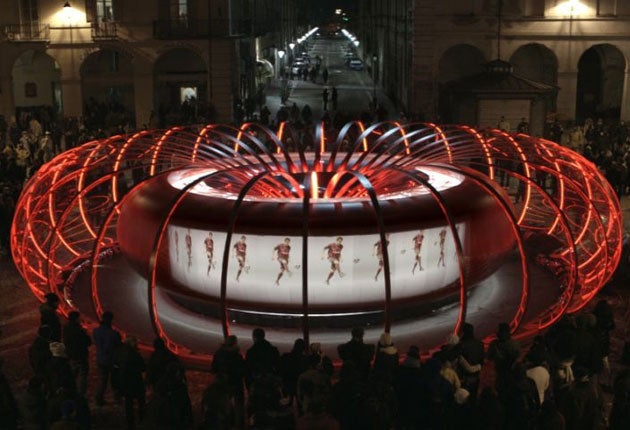Claire Beale on Advertising: Send the Martians home, it's time for change

Your support helps us to tell the story
From reproductive rights to climate change to Big Tech, The Independent is on the ground when the story is developing. Whether it's investigating the financials of Elon Musk's pro-Trump PAC or producing our latest documentary, 'The A Word', which shines a light on the American women fighting for reproductive rights, we know how important it is to parse out the facts from the messaging.
At such a critical moment in US history, we need reporters on the ground. Your donation allows us to keep sending journalists to speak to both sides of the story.
The Independent is trusted by Americans across the entire political spectrum. And unlike many other quality news outlets, we choose not to lock Americans out of our reporting and analysis with paywalls. We believe quality journalism should be available to everyone, paid for by those who can afford it.
Your support makes all the difference.You could be forgiven for thinking that adland has run dry, that like the rest of us it's bankrupt. How else to explain the rampage of nostalgia swarming across our TV screens in 30-second bites?
Honey Monster's getting cosy with the Smash Martians; Bertie Bassett's buddying up to Captain Birdseye; and the Churchill dog's been sniffing around the Peperami animal in a new ad for Comic Relief that wallows in the brand icons of the advertising annals. Meanwhile, Heinz has been recutting all its old ads into a new commercial soup, Asda's bringing back its arse-slapping mums in a return to its blunt value message, and even Boursin is excavating its old ad slogan "du pain, du vin, du Boursin".
Cynics will question whether turning misty eyes to the advertising past is simply a reflection of a modern creative drought. Have ad agencies used up all the good ideas and been forced to revive some from adland's heydays? Have clients slashed budgets and agency fees so deeply that recycling commercials has become the only cost-effective solution?
Or is the trend for nostalgia a considered response to a cultural state of mind and a shrewd bit of bandwagon-jumping? Agencies will tell you it's the latter, and not just because they'd never admit to the former: nostalgia is very much of the moment. The current financial climate is fostering a back-to-basics attitude that celebrates our less complicated recent history and hankers for the innocently halcyon days of a decade or two ago. Things that are familiar, that are simple, that are old friends are particularly comforting at a time when what's happening now is scary.
So nostalgia has a fundamental appeal and it's a trend that the media is keen to manipulate. People who now control the media lens through which so many of us view the world grew up with Smash Martians and Beanz Meanz Heinz kids. They hold rich associations of blissful childhoods. Is it any wonder we're suckers for writing about these icons, putting them back into ads, making TV programmes celebrating them?
All of which is convenient for advertisers facing recession. First, nostalgia is likely to generate a nice bit of PR; commissioning journalists are likely to share the fondness for the brand icons they grew up with and know that stories about them will appeal to their audience.
And resurrecting old brand icons is a shrewd, cost-effective move in a climate where budgets are tight. The Captain Birdseyes and Honey Monsters have proven their appeal to consumers over the long haul, so they're hardly risky choices; most advertisers aren't of a mind to take risks right now.
What's more, these old brand icons have a familiarity that's been built up over years of expensive media investment, so it's cost-efficient to make that investment continue to pay dividends rather than starting again from scratch. If you see a middle-aged housewife slapping her backside on TV, you know immediately she's selling Asda; the cut-through is quicker, greater and cheaper.
So we all love a bit of nostalgia. But will it actually shift products off shelves? After all, when Woolworths went under it prompted an indulgent wave of nostalgia for the brand, but that didn't count for a jot to Woolies' bottom line. We'd rather shop online or from modern, streamlined stores.
And, like all advertising trends, they work best if you're riding the crest. Too much nostalgia and it will become like wallpaper; we'll stop taking notice. Let's be honest now, it's not even as if most of the ads we're getting gooey about were actually very good. Certainly not when set against some of the multi-media, interactive, commercials of the past couple of years.
Which is why, even though budgets might be tight and creative inspiration might be costly, going back to the past is playing it too safe.
Crisis is the perfect time to take bold decisions, try something different, to surprise and challenge. Nostalgia might be comfy, but it's also risk-averse and right now, that's quite a risk to take.
Best in Show: Sony Bravia (Fallon)
*No apologies to anyone keeping a tally of these things: this week I've chosen another ad from Fallon. It simply happens to be the agency that's come roaring off the blocks this year with some interesting, high profile and inspiring work.
Its latest Sony Bravia commercial is no exception. Footballer Kaka meets a 10-ton zoetrope and the result is stunning. You'll have to watch it on the web with creative aficionados, though (type Sony zoetrope into Youtube) because it's not out on TV here yet.
Join our commenting forum
Join thought-provoking conversations, follow other Independent readers and see their replies
Comments